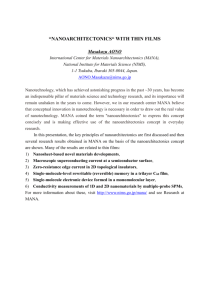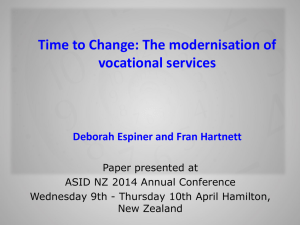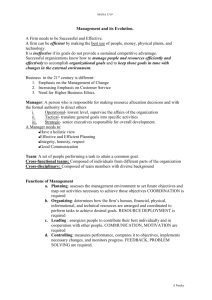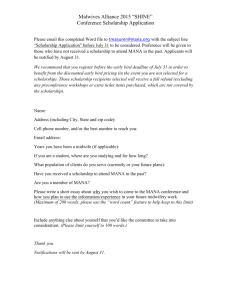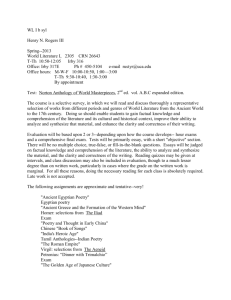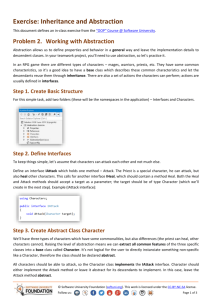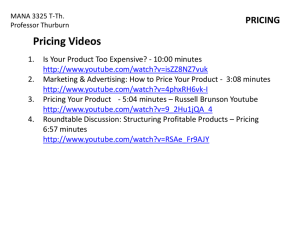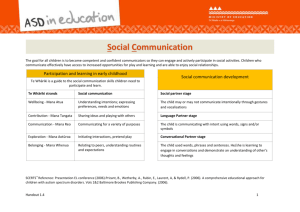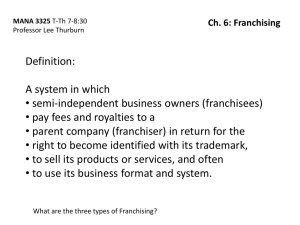Chapter #8 – Marketing - Elements of Entrepreneurship
advertisement
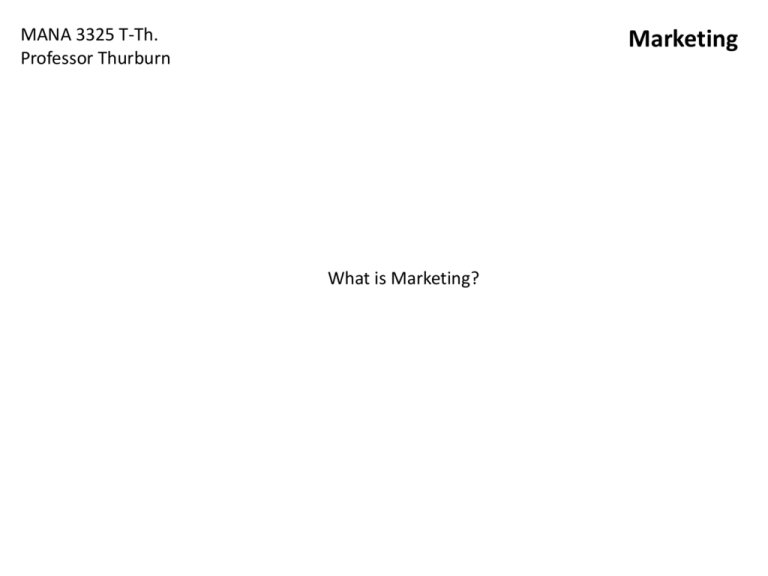
MANA 3325 T-Th. Professor Thurburn Marketing What is Marketing? MANA 3325 T-Th. Professor Thurburn Marketing Marketing Definition: 1. The process of creating and delivering desired goods and services to customers. 2. Involves all of the activities associated with winning and retaining loyal customers. 3. Includes Market Research, Advertising, Selling, and Customer Support MANA 3325 T-Th. Professor Thurburn Marketing Advertising Definition: 1. Advertising Supports Sales. 2. Advertising is NOT the same as Sales or Selling. 3. Advertising Builds Awareness, Trust, Confidence, and when done well Leads a Prospect to the Sales Cycle Entry Point… Taking an Action that leads to a sale. MANA 3325 T-Th. Professor Thurburn Marketing Selling Definition: 1. 2. 3. 4. Exchange of Money for Products or Services The Most Critical Step in the Marketing Cycle May happen with or without human interaction. Buyer MUST overcome their reluctance to separate from their money. MANA 3325 T-Th. Professor Thurburn Selling Made Simple: 1. People Only Buy What They Want 2. Selling is the Art of converting a Need to a Want. 3. Selling effectively requires Creating a Sense of Urgency. 4. People rarely buy today what they can purchase tomorrow. 5. Time Kills Deals! Marketing MANA 3325 T-Th. Professor Thurburn The Purchase Cycle Marketing MANA 3325 T-Th. Professor Thurburn Marketing MANA 3325 T-Th. Professor Thurburn Marketing The Consumer Perception Process Awareness Top of Mind Awareness Expertise or Authority The IBM Paradigm Trust and Confidence MANA 3325 T-Th. Professor Thurburn Step 1 - Building Awareness: Traditional Media 1. 2. 3. 4. 5. 6. 7. Television Radio Print Media Direct Mail Signs Exhibits & Expos Others? Marketing MANA 3325 T-Th. Professor Thurburn Step 1 - Building Awareness: Digital Media 1. 2. 3. 4. 5. 6. 7. 8. 9. Email Marketing Websites SEO Social Media PPC Advertising Banner Advertising Video Marketing Google Hangouts Others? Marketing MANA 3325 T-Th. Professor Thurburn Marketing What is primary difference between Traditional Marketing and Digital Marketing? Interactivity! MANA 3325 T-Th. Professor Thurburn Marketing Guerilla Marketing Definition: 1. Are unconventional, low-cost, and creative marketing techniques that allow a small company to realize a greater return from its marketing investment than do larger rivals. 2. Do not require large amounts of money to be effective – just creativity. MANA 3325 T-Th. Professor Thurburn Guerilla Marketing Myth: Free and Easy… …just need to figure out the magic formula. Marketing MANA 3325 T-Th. Professor Thurburn Guerilla Marketing Reality: All Marketing costs either 1. Time… or 2. Money… or 3. Both Marketing MANA 3325 T-Th. Professor Thurburn Marketing Guerilla Marketing Principles: 1. Find a niche and fill it. 2. Use the power of publicity 3. Don’t just sell… entertain!... “Entertailing” 4. Strive to be unique. 5. Connect with customers on an emotional level. • Build trust • Define a unique selling proposition (USP) MANA 3325 T-Th. Professor Thurburn Marketing Unique Selling Proposition: 1. A key customer benefit of a product or service that sets it apart from its competition. 2. Answers key customer question: “What’s in it for me?” WiiFM 3. Consider intangible or psychological benefits as well as tangible ones. 4. Communicate your USP to your customers often. MANA 3325 T-Th. Professor Thurburn Marketing More Guerilla Marketing Principles: Create an identity for your business through branding. Embrace social networking. Start a blog. Create online videos. Host a special event. Focus on customer satisfaction. Retain existing customers Be devoted to quality. Pay attention to convenience. MANA 3325 T-Th. Professor Thurburn USP and Brand Relationship: Marketing MANA 3325 T-Th. Professor Thurburn USP and Brand Relationship: Threshold Attributes • Does it work? Performance Attributes • Is it easy? Excitement Attributes • Does it Deliver Results Wanted? Marketing MANA 3325 T-Th. Professor Thurburn Marketing Building a Brand: Relevance High “Antes” “Drivers” Features that are important to customers but all competitors provide them Features that are both important to customers and are highly differentiated from those of competitors Every company in the market must “ante up” on these features. These are the attributes on which a company must focus to build its brand.1 “Neutrals” “Fool’s Gold” Features that are irrelevant to customers Features that are unique to your company but do not drive customers’ loyalty to your product and services These features are useless when it comes to branding. Low Low Don’t make the mistake of trying to build a brand on these features! Differentiation High MANA 3325 T-Th. Professor Thurburn Marketing Embrace Social Media: 1. Social networks sites, such as Facebook, LinkedIn, and Twitter, allow entrepreneurs to connect with potential and existing customers at little or no cost. 2. 44% of entrepreneurs use social media to connect with existing and potential customers. MANA 3325 T-Th. Professor Thurburn Marketing Blog Marketing Guidelines: 1. Be honest, balanced, and interesting. 2. Post blog entries consistently so that readers have a reason to return. 3. Ask customers for feedback. 4. Strive to cultivate the image of an expert or a trusted friend on a topic that is important. 5. Use services (ie:Google Alerts) that scan for a company’s name and send e-mail alerts when they find posts. 6. Promote the blog via e-mail and promotional Web Sites. MANA 3325 T-Th. Professor Thurburn Marketing Video Marketing: YouTube reports that visitors view 3 billion videos per day. Online video guidelines: 1. Think “edutainment.” 2. Be funny. 3. Tell Stories. 4. Post videos on multiple social media sites. 5. Involve customers. 6. Keep it short. MANA 3325 T-Th. Professor Thurburn Marketing Customer Service: Customer Experience Management (CEM) 1. Surveys show 79% of unhappy customers tell others about their experiences. 2. 48% of shoppers say they won’t patronize stores where they know others have had negative experiences. 3. For every complaint a company receives, 17 other complaints go unspoken. 4. Disgruntled customers often post their experiences online. 5. 80% of shoppers have changed their minds about a purchase after reading negative information online. MANA 3325 T-Th. Professor Thurburn Marketing Customer Service: (CEM) To achieve stellar customer service and customer satisfaction: 1. Examine your company’s service cycle 2. Set standards and measure performance 3. See customer complaints as a mechanism for improving customer service 4. Listen to customers 5. Define superior service MANA 3325 T-Th. Professor Thurburn Marketing Customer Service: (CEM) 1. Treat employees with respect and show them how valuable they are 2. Use technology to provide improved experience 3. View customer service as an investment, not an expense 4. Reward superior service 5. Give customers an unexpected surprise MANA 3325 T-Th. Professor Thurburn Marketing Customer Service: (CEM) Every customer interaction should be… • Intimate • Personal • Consistent, courteous, and professional • Responsive • Helpful information and advice • Involvement of caring, well-trained people • Long-term relationship view • Emphasis on sustaining an ongoing relationship • Nurturing the company/customer relationship Which Leads to… MANA 3325 T-Th. Professor Thurburn Marketing Customer Service: (CEM) Every customer interaction should be… • Intimate • Personal • Consistent, courteous, and professional Which Leads to… • Responsive Satisfied, loyal, repeat • Helpful information and advice (and profitable) • Involvement of caring, well-trained people • Long-term relationship view • Emphasis on sustaining an ongoing relationship • Nurturing the company/customer relationship customers MANA 3325 T-Th. Professor Thurburn Marketing Retain Existing Customers: (CEM) 1. A company must land 12 to 20 new customers to offset the impact of one lost loyal customer! 2. Research shows that repeat customers spend 67% more than new customers. 3. Attracting new customers costs the typical business 7 to 9 times as much as keeping existing customers. 4. Practice customer experience management. MANA 3325 T-Th. Professor Thurburn Marketing Retain Existing Customers: (CEM) Companies that are successful at retaining their customers constantly ask themselves (and their customers) 4 questions: 1. What are we doing right? 2. How can we do that even better? 3. What have we done wrong? 4. What can we do in the future? MANA 3325 T-Th. Professor Thurburn Marketing How Americans Define Product Quality: 1. Reliability (average time between breakdowns) 2. Durability (how long an item lasts) 3. Ease of use 4. Known or trusted brand name 5. Low price MANA 3325 T-Th. Professor Thurburn Marketing How Americans Define Service Quality: 1. Tangibles - equipment, facilities, people 2. Reliability - doing what you say you will do 3. Responsiveness – promptness in helping customers 4. Assurance and empathy - conveying a caring attitude
